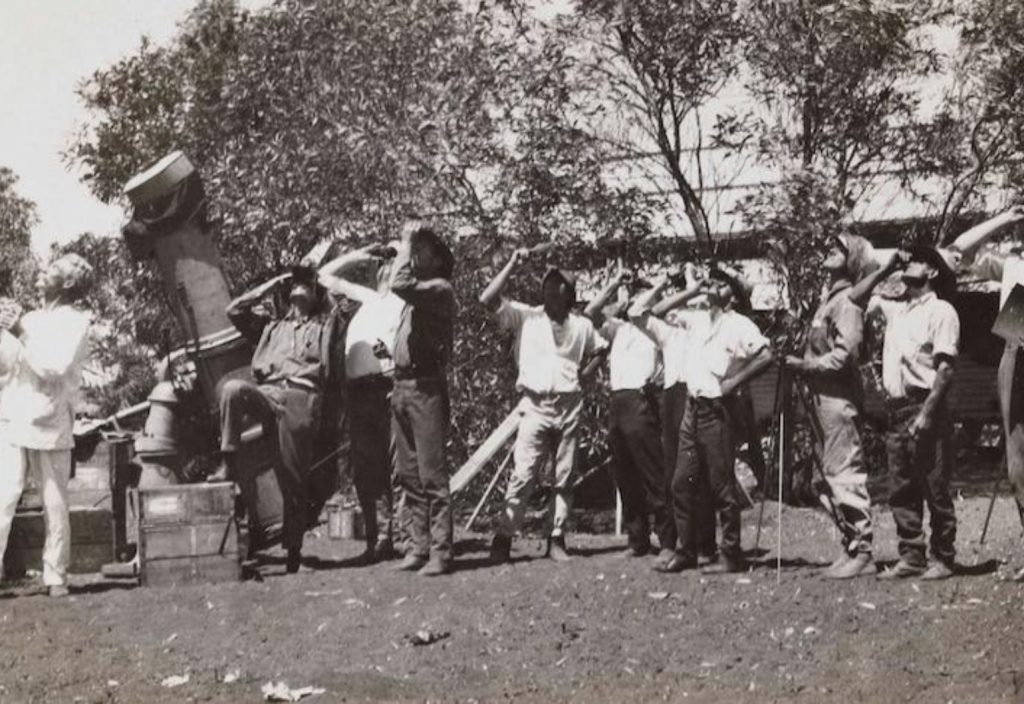The eyes of the world were on north-west Western Australia today for a solar eclipse, but few know of the incredible engineering feats the last eclipse in the region inspired.
On April 20, a narrow strip of northern Australia experienced a total solar eclipse.
It took just three minutes and 19 seconds for the moon to pass directly in front of the sun, but the region was the focus of countless live streams and international science experiments for that period. The small town of Exmouth attracted thousands of visitors hoping for the perfect opportunity to view the once-in-a-lifetime solar eclipse.
The eclipse is also the perfect opportunity to reflect on the extraordinary engineering and scientific achievements that occurred the last time the region experienced a solar eclipse, more than a century ago.
Putting Einstein to the test
The Wallal Expedition of 1922 had a single, lofty objective — measuring the positions of the stars during the solar eclipse with incredible precision, enabling the team to test Einstein’s Theory of Relativity and its prediction that gravity is the curvature of space.
Professor David Blair, winner of numerous prestigious awards including the Prime Minister’s Science Prize and the Eureka Prize, said the theory predicted that light from a distant star would bend as it entered our sun’s gravitational field.
“This idea could be tested by capturing light beams on photographs, provided they were not blotted out by the overwhelming light of the sun,” he said.
“People had the cameras — they just needed a total solar eclipse to test the theory.”
This meant a large team of scientists and engineers had to transport 35 tonnes of equipment to a remote location in Western Australia’s north, overcoming treacherous waves and sand dunes in the process.

The destination, on the coast between Port Hedland and Broome, at the time had a telegraph station, an Indigenous population of about 100 people and little else.
The expedition needed to build a large structure in the remotest of conditions in order to house the large telescope. They also needed to set up a host of instruments to measure temperature, air pressure, humidity, and wind speed and direction. Radio was used to feed in accurate time measurements from the Perth and Adelaide observatories, as well as observatories in the United States and France.
“With no vehicles apart from donkey wagons and human effort, they had less than three weeks to assemble huge towers and clockwork mechanisms for correcting the Earth’s rotation to track stars during long exposure images,” Blair said.
“The astronomers measured star positions to about five parts in 100 million, a level of accuracy that was not surpassed for 50 years, until spacecraft and radio astronomy techniques allowed for further improvements.
At a time when the scientific and engineering sector was dominated by white men, women and Indigenous people played a significant role in the success of the expedition.
More than 50 Nyangumarta people were trained to help with the building process, while the wives of the scientists were also instrumental in the mission’s success.
A national sensation
To develop the photographs that could prove the theory, the researchers pitched a tent between trees to create a darkroom. When it proved too dusty, the photographs that would change the world of science were developed at the Broome Coastal Radio Station.
For centuries, people believed that space was fixed and unchangeable. However, the Wallal Expedition proved that space was stretchy, bendy, and curved, confirming Einstein’s predictions and his theory of relativity.
The discovery was a national sensation, captivating everyone from Prime Minister Billy Hughes to aviator Kingsford Smith, and it remains one of the most significant scientific achievements in Australia’s history.
“This was perhaps the most important physics discovery ever made in Australia,” Blair said.
“As engineers, we should take inspiration from the Wallal Expedition and strive to work together towards common goals. Let us remember the remarkable achievements of the Wallal Expedition and celebrate the power of human ingenuity and cooperation.”
The expedition to Wallal and the ensuing scientific revolution is chronicled in the book Uncovering Einstein’s New Universe by Professor David Blair, Ron Burman and Paul Davies.
